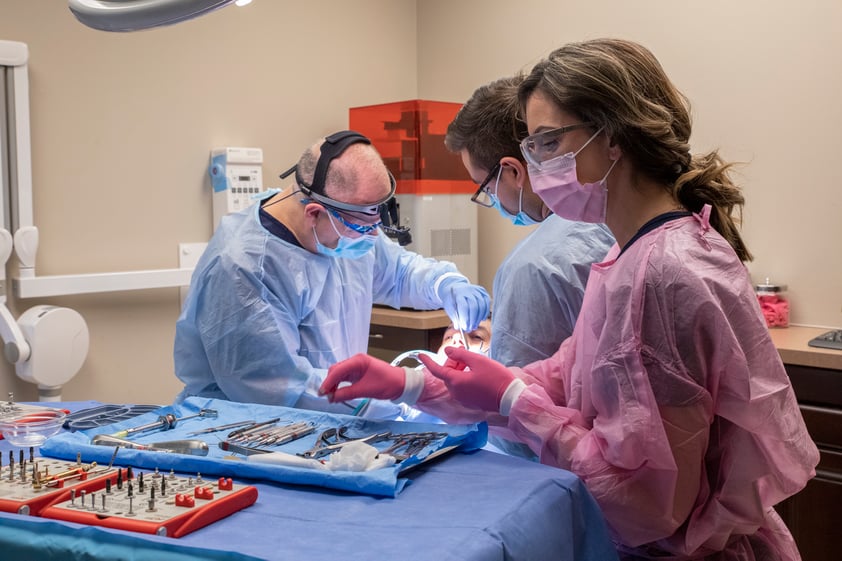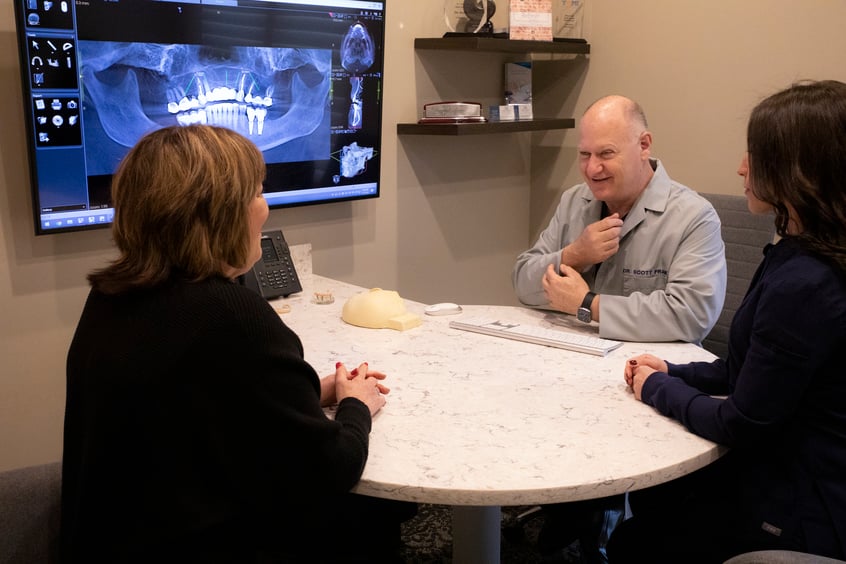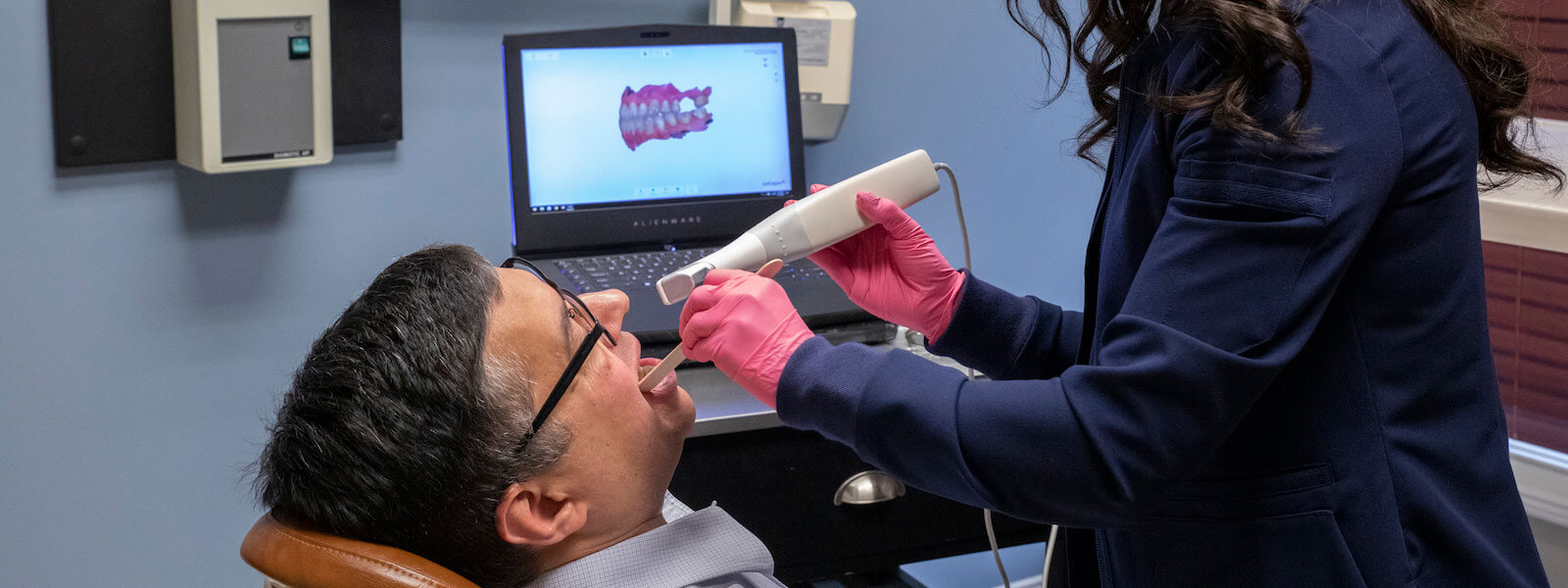Finding a Good Dental Surgeon for Implants
One patient I had, treated, Mark, played in a softball league. He was playing with his team on the evening days before his wedding. During the game, he was hit in the face by a bat, knocking his two upper front teeth out. The ball fractured his two front teeth down to the gum-line. He started and continued to bleed profusely and called contacted my office for an emergency care and in a panic as his wedding was in a few days!
Once in the chair, I was able to get the bleeding under control. Working closely with his restorative dentist, we developed a plan to have him ready for his wedding. After sedating him, I removed the fractured, non-repairable teeth and immediately placed the two necessary dental implants with bone grafting. During the same appointment, I placed custom posts to allow the restorative doctor to provide replacement crowns on the same day, complete with teeth that blended seamlessly into his natural smile.
Using advanced digital dental technology and working closely with the patient’s own dentist, he was awake, alert, and the swelling was well on its way to being under control, with beautiful, non-removable new front teeth within a few hours. The next day, he attended his wedding with a gorgeous smile, pain-free, and no one was the wiser. Now this story had a happy ending partially because Mark chose the right dental surgeon and implant team as many would not be able to offer the same treatment.

EDUCATION AND COLLABORATION
It’s vital that an implant surgeon remains a perpetual student because little to none of the knowledge needed to do implants is taught in general dental school. I suggest that anyone considering implants should find a surgeon that has gotten at least three or more years of additional surgical training after they’ve finished dental school.As an Oral and Maxillofacial surgeon, I spent years studying surgical techniques that ranged from simple tooth removal to complete facial bone and tissue reconstruction before I entered into private practice. Years of surgical training provides extensive knowledge of anatomy, managing complications, and anesthesia techniques.
Getting implants is a two-step process that requires collaboration and teamwork between an oral surgeon and a restorative dentist. Education is key and plays a large part of why I offer continuing education to dentists on a host of implant and surgery aspects. This allows the collaboration process to flow more seamlessly.
Once an oral surgeon has placed the implants, the patient then follows up with a general or restorative dentist who possesses expertise in fillings, crowns, veneers, bridges, dentures – the aesthetic part of the implant.
This is not to say that general or restorative dentists can’t and don’t sometimes take care of the entire implant process. However, most dentists don’t perform implant surgery often and it is usually the most difficult and complex service they offer. In my experience, it’s best to complete the process with a surgical specialist and a restorative dentist that value collaboration and working together to obtain the best possible results. This allows each doctor to perform where they excel in their respective fields and provide the most favorable outcome for the patient.

New DENTAL Technology and Techniques
The field of dental implants is constantly changing and developing. Digital technology is quickly improving the way dental implants are designed and installed. One of the most important developments in recent years is the 3D x-ray, also called a Cone-Beam Computed Tomography (CBCT) scan. This enables an implant surgeon to view and identify bone volume, contour, and vital structures such as nerves and the sinuses.
These x-rays provide critical information for a surgeon to map out and precisely plan implant placement, avoiding undesirable complications. The information offered by 3D x-rays allows a surgeon to make better surgical choices, which in turn lead to better short and long-term results for the patient.
Another advancement in the digital world involves merging of 3D x-rays and digitally generated impressions, where a camera is used to generate a digital impression instead of a physical one (using the “goop” which so many patients dislike). The information gathered enables a surgeon to recreate your entire mouth and head on the computer and perform “virtual surgery”. This makes it possible for a surgeon to identify ideal results and complete “run-through” of the implant surgery before ever touching the patient. The surgeon can identify and note ideal positions and placement for implants, as well as mark trouble spots and areas to be avoided.
In my practice, we utilize a 3-D printer to fabricate a surgical guide that allows for precise placement of dental implants as planned for in the “virtual surgery.” Utilizing digital dental technology is advanced and most surgeons do not have the training or knowledge to offer such progressive treatment. My philosophy is to use advanced digital technology to obtain the best possible results for every implant, in every patient, no matter how simple or complex the case. I certainly would want the best results in my mouth every time!
Once the surgery is complete, digital technology can be used, again, to provide excellent results. When “testing” dental implants to confirm adequate and successful healing, a digital impression is taken during this follow up visit. A digital shade is also obtained to create the most accurate tooth color to match the existing teeth. This impression is sent to the restorative dentist to design and plan the custom implant supported teeth on the computer. This inevitably saves the patient time (less visits and less time at the office) and generally leads to the most aesthetically-pleasing smile.
I would like to share and emphasize the important fact: not all dental implants surgeons, restorative doctors, dental implant companies, dental labs, dental implant techniques and even patients are created equal. There are variables that can and do affect treatment and the end result. An important part of my practice is to educate patients and aid patients in obtaining the best possible outcome.
If you're ready to talk about your dental implant options, reach out to my team so we can set up a consultation today!
This blog post is based on an excerpt from Dr. Scott Frank's chapter in the book, "A Reason to Smile: Fixing Broken Confidence with Cosmetic Dentistry."



